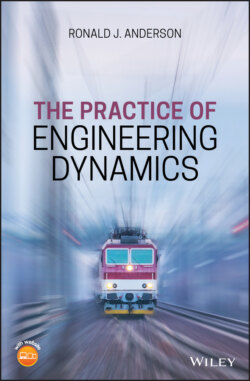Читать книгу The Practice of Engineering Dynamics - Ronald J. Anderson - Страница 17
1.4 Two Dimensional Motion with Variable Length
ОглавлениеFigure 1.4 shows a rigid body rotating in a plane about a fixed point . The body has a slot cut in it and a small object slides in this slot. Expressions for the velocity and acceleration of are desired.
Figure 1.4 A slider in a slot.
Since the distance from to changes with time, we start by defining a variable distance from to . A set of rotating unit vectors (, , ), fixed in the rotating body, as shown, is appropriate for this analysis since the position vector is aligned with , thereby making it easy to write.
The angular velocity of the body is not specified in magnitude but the fact that the body rotates in a plane fixes the direction of the angular velocity to be . We assume that the angular velocity is,
where is not constant so that (i.e. the rate of change of magnitude of the angular velocity vector) exists.
The position of with respect to is then,
and, differentiating this, we find the velocity of with respect to to be,
(1.19)
The acceleration of the slider relative to point is defined to be,
or
(1.20)
Since both the velocity and the acceleration are relative to the fixed or inertial point , they are in fact the absolute velocity and acceleration of point . We commonly write absolute velocities and accelerations without subscripts yielding,
(1.21)
and
(1.22)
